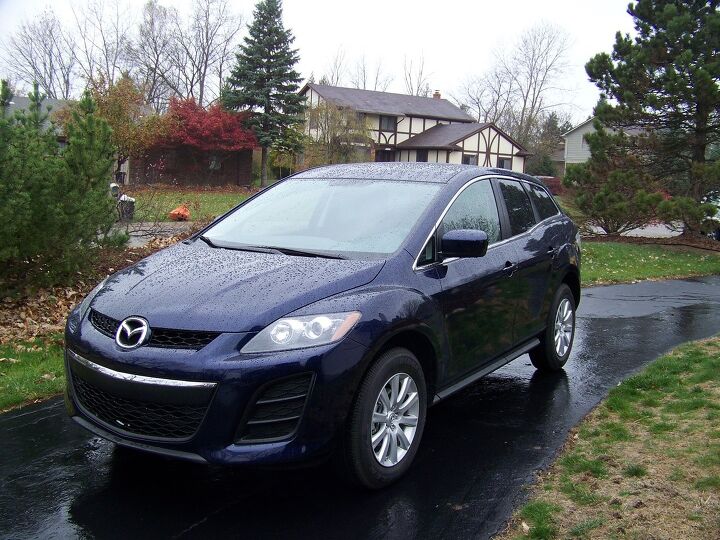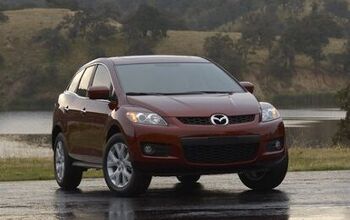Review: 2011 Mazda CX-7 ISport
With the 2007 model year introduction of the CX-7, Mazda arrived late to the compact crossover party. And when you arrive late, you’d better bring something special. To this end, the CX-7 combined swoopy styling and a standard turbocharged engine, making it arguably the sportiest offering in the segment. After an initial burst, during which everyone who really wanted one bought one, sales have been modest. In a bid to broaden the CX-7s appeal, Mazda added a non-turbocharged four as part of a 2010 refresh. But if you take away one of the few things that made the CX-7 special, is there any reason to buy one?
The CX-7’s styling remains much the same after last year’s refresh. The crossover’s nose is a little more blunt than earlier, with a new band of chrome along the upper edge of the lower grille to take it a quarter-notch upscale. But the fender bulges, steeply raked windshield, and basically ovoid shape remain the same. People who liked the look of the CX-7 before will still like it. And those who didn’t still won’t. The i Sport’s 215/70HR17 tires appear lost within wheel openings sized for low-profile 19s, and do the CX-7 no aesthetic favors. Low profile tires have become so common, it’s almost hard to believe 70s are still around.
Why such unsporting tires on the i Sport? Well, within Mazda’s current naming scheme, which rivals BMW’s in its capacity to confound, “Sport” means one step up from the SV, with the latter much more prevalent in dealer ads than on dealer lots. So “Sport” essentially means “base.”
Inside, the CX-7’s styling has been refined, with minor tweaks to the trim, but you’ll probably have to compare before and after photographs to spot the differences. For example: the bands of chrome that outline the sides of the center stack no longer connect at the bottom to form a U, and have been joined by additional bands of trim in gunmetal blue. This interior remains more attractive and interesting to look at than the segment norm, but with all manufacturers focusing more and more on design the gap has been closing.
The largest change: the dash now humps up a bit over the top of the center stack to open up space for a pair of small, four-inch LCD screens. One of these houses the optional rearview camera display and, in the Grand Touring, the navigation display. Compared to the 2007-2009’s seven-inch display it’s much smaller, especially when you factor in that it’s also farther away, but located closer to the driver’s sightlines. And no doubt cheaper, though how expensive is a seven-inch LCD these days? The original display in the new location would be much better than either thus far offered alternative.
The large, steeply raked windshield and the windowlettes that flank it make for a driving position that’s more minivan than SUV. The seats front and rear are firm and fairly comfortable. There’s more shoulder room than in other compact crossovers, such that the CX-7 feels almost mid-sized from the driver’s seat. But paradoxically there’s less legroom than in the average compact crossover. Still enough for the average adult, but the Honda CR-V and Toyota RAV4 surprise (and delight?) in this area. Cargo volume is similarly compromised by the ovoid shape yet still adequate.
Compared to the competition, the CX-7’s 2.5-liter four is down about twenty horsepower (161 at the 6,000 rpm peak), and it must accelerate about one hundred additional pounds (3,496). In practice, even with a five-speed automatic (the RAV4 benefits from an additional cog) acceleration is thoroughly adequate, if a bit buzzy at low rpm. Fuel economy is about 21 in typical suburban driving, though as high as 26 along one casual stretch. For those who desire more of a rush (at the expense of fuel economy) the 244-horsepower boosted four remains available, and mandatory with all-wheel-drive. Honda and Toyota offer all-wheel-drive with the normally-aspirated fours in the CR-V and RAV4. The 2.5 performs well enough in the CX-7 that I wonder why Mazda doesn’t do the same.
I was underwhelmed by the Mazda CX-7’s handling when I first drove it about four years ago. The exterior styling promised considerably more entertainment than the chassis could deliver. Adding tires with tall, ride-oriented sidewalls does not help. So equipped, and further saddled with slow steering, the CX-7 feels large and soft. Ride quality is generally good, though some roads unsettle the chassis. Overall, this is the rare Mazda that trails its competition in terms of driving enjoyment.
With the $1,750 Convenience Package (sunroof, rearview monitor, automatic climate control, power driver seat), the 2011 Mazda CX-7 i Sport lists for $25,340. A little pricey compared to a similarly equipped car—a Mazda3 s costs over $2,000 less while being more economical and orders of magnitude more fun to drive—but within a few hundred dollars of the CR-V and RAV4. Based on responses to TrueDelta’s Car Reliability Survey, the CX-7 got off to a rocky start back in 2007, but has since improved to average for both the 2007 and 2008 model years. (Much lower sales in recent model years have resulted in insufficient sample sizes.) Many of the earlier problems involved the turbocharged four. With the non-turbo 2.5-liter engine the CX-7 should be reliable.
For decades Mazda has struggled to survive, periodically aspiring to become a first-tier auto maker but each time falling short. Their successes have followed from emphasizing the fun-to-drive qualities of much of their cars. But the enthusiast market just isn’t large enough, especially not in the compact crossover segment. Problem is, remove the turbocharged four from the CX-7, and what little excitement the CX-7 offered along with it, and there’s no compelling reason to buy a CX-7 instead of a CR-V or RAV4 unless you really like how it looks. And if you care about how it looks, you’re going to want to replace those 17s.
Mazda provided the vehicle, insurance and one tank of gas for this review
Michael Karesh owns and operates TrueDelta, an online source of automotive reliability and pricing data.
Michael Karesh lives in West Bloomfield, Michigan, with his wife and three children. In 2003 he received a Ph.D. from the University of Chicago. While in Chicago he worked at the National Opinion Research Center, a leader in the field of survey research. For his doctoral thesis, he spent a year-and-a-half inside an automaker studying how and how well it understood consumers when developing new products. While pursuing the degree he taught consumer behavior and product development at Oakland University. Since 1999, he has contributed auto reviews to Epinions, where he is currently one of two people in charge of the autos section. Since earning the degree he has continued to care for his children (school, gymnastics, tae-kwan-do...) and write reviews for Epinions and, more recently, The Truth About Cars while developing TrueDelta, a vehicle reliability and price comparison site.
More by Michael Karesh
Latest Car Reviews
Read moreLatest Product Reviews
Read moreRecent Comments
- Lichtronamo Watch as the non-us based automakers shift more production to Mexico in the future.
- 28-Cars-Later " Electrek recently dug around in Tesla’s online parts catalog and found that the windshield costs a whopping $1,900 to replace.To be fair, that’s around what a Mercedes S-Class or Rivian windshield costs, but the Tesla’s glass is unique because of its shape. It’s also worth noting that most insurance plans have glass replacement options that can make the repair a low- or zero-cost issue. "Now I understand why my insurance is so high despite no claims for years and about 7,500 annual miles between three cars.
- AMcA My theory is that that when the Big 3 gave away the store to the UAW in the last contract, there was a side deal in which the UAW promised to go after the non-organized transplant plants. Even the UAW understands that if the wage differential gets too high it's gonna kill the golden goose.
- MKizzy Why else does range matter? Because in the EV advocate's dream scenario of a post-ICE future, the average multi-car household will find itself with more EVs in their garages and driveways than places to plug them in or the capacity to charge then all at once without significant electrical upgrades. Unless each vehicle has enough range to allow for multiple days without plugging in, fighting over charging access in multi-EV households will be right up there with finances for causes of domestic strife.
- 28-Cars-Later WSJ blurb in Think or Swim:Workers at Volkswagen's Tennessee factory voted to join the United Auto Workers, marking a historic win for the 89- year-old union that is seeking to expand where it has struggled before, with foreign-owned factories in the South.The vote is a breakthrough for the UAW, whose membership has shrunk by about three-quarters since the 1970s, to less than 400,000 workers last year.UAW leaders have hitched their growth ambitions to organizing nonunion auto factories, many of which are in southern states where the Detroit-based labor group has failed several times and antiunion sentiment abounds."People are ready for change," said Kelcey Smith, 48, who has worked in the VW plant's paint shop for about a year, after leaving his job at an Amazon.com warehouse in town. "We look forward to making history and bringing change throughout the entire South." ...Start the clock on a Chattanooga shutdown.












































Comments
Join the conversation
We leased a 2007 FWD Grand Touring in May '07 and put 40+ thousand on it before turning it back in. I loved the look of it, very comfortable on trips, and had no issues at all after a couple of initial TSBs for the climate control unit, ECU mapping, and door seals during the first six months. We'd average 24'ish mpg in routine use (suburban + freeway, in our case), saw upper 20's on light-footed highway driving, 18 or so in lead-footed use (four score and above in Western states). After it all, I still don't get the original choice of a complicated, expensive, turbo-four for this vehicle; it really needs a nice, torque-y V6 for its intended user base, or couple the turbo-four with a manual (not that doing so would make sense for its 90th percentile target market RAV4/CRV shoppers). As configured, it was all-too-easy to catch the turbo napping, like when waiting in traffic for a spot to make your left turn..."punching it" delivered too little just off idle (even after the ECU change), and it made for some nervous, thank-God-for-side-impact-beams moments while waiting for the boost to build. One learned to "pre-stage" with some NHRA-style left-foot-braking if a quick launch was needed. Oh, and the stock tires were crap in the snow; shocked at how immobilized it was in our first minor snowfall, I mounted Nokians each winter thereafter and had no issues.
No stick shift = 0 interest.